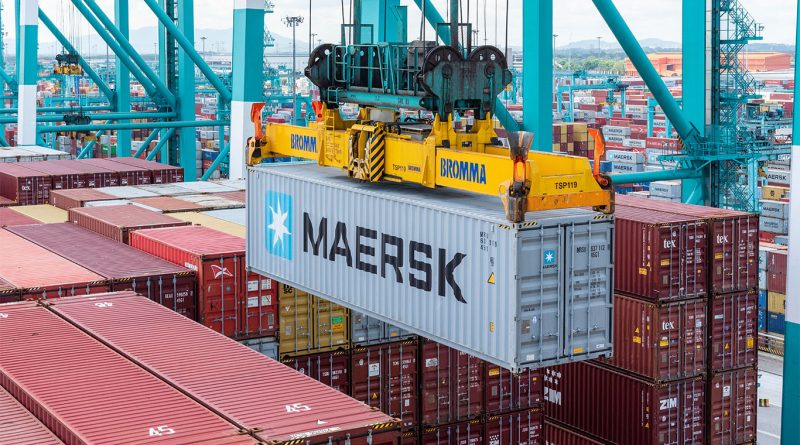Maersk Q2 earnings rise as global container trade exceeds forecasts, but flags risks in US
Subscribe to our free newsletter today to keep up to date with the latest transportation and logistics news.
A.P. Moller–Maersk delivered a stronger-than-expected performance in the second quarter of 2025, signaling stability in global shipping despite ongoing trade uncertainties. The Danish shipping giant posted an underlying EBITDA of $2.3 billion, exceeding analyst estimates of $1.98 billion. Revenue reached $13.1 billion, representing a 3 percent year-over-year increase.
These results reflect a rebound in global container volumes and relatively steady freight rates. While volatility persists, Maersk’s operational control and cost management contributed to this positive performance. The second quarter followed a solid first quarter, in which the company reported $13.3 billion in revenue and a significant increase in EBIT, rising from $177 million to $1.3 billion compared to the prior year.
Upward revision of full-year guidance reflects confidence in demand
Maersk has raised its full-year EBITDA guidance to a range between $8 billion and $9.5 billion, an increase from the previously announced range of $6 billion to $9 billion. This revision signals stronger confidence in underlying market conditions, particularly as global demand for container services has shown resilience.
The company also upgraded its global container volume growth forecast for the year, now expecting an increase between 2 percent and 4 percent. The earlier forecast ranged from a contraction of 1 percent to an increase of 4 percent. These changes reflect continued strength in key shipping corridors and an ability to hold pricing levels in a competitive environment.
Operational reliability and schedule improvements contributed to Maersk’s confidence in adjusting its guidance. The company pointed to stronger-than-expected volumes and stable logistics demand as reasons for the revision.
Vincent Clerc highlights operational agility amid global trade risks
Chief Executive Officer Vincent Clerc emphasized the importance of flexibility and resilience in the face of ongoing trade disruption. He pointed to strong demand across major routes, including Asia–Europe and the transpacific corridor, as evidence that global supply chains are adapting rather than retreating.
Clerc acknowledged that geopolitical uncertainty, particularly in regions such as the Red Sea and Eastern Europe, continues to influence customer behavior. He also noted that recent trade policy shifts in the United States, particularly the fluctuating implementation of tariffs, have had a slightly dampening effect on demand. While global container volumes are growing, US-bound trade in particular saw some pressure as businesses responded cautiously to unpredictable cost structures tied to changing tariff rules.
Despite these headwinds, Clerc cited Maersk’s diversified logistics platform as a buffer. The company’s ability to manage capacity, maintain service levels, and offer integrated logistics solutions has reduced the volatility seen in prior years.
Shipping sector performance points to broadening recovery
Maersk’s performance coincides with broader indications that the global container shipping sector is stabilizing. While freight rates remain below peak levels, they have shown signs of settling within a sustainable range. Container throughput at major ports in Asia and Europe has improved, and several peer companies have reported volume growth consistent with Maersk’s experience.
Although certain economic indicators remain mixed, particularly in the European consumer sector, underlying trade flows are becoming more predictable. Maersk’s updated forecast of container growth between 2 percent and 4 percent suggests that inventory restocking and seasonal flows are returning to historical patterns.
The shipping sector’s capacity management has also played a role. Carriers have adjusted services, consolidated routes, and improved vessel utilization to better align with demand. As a result, the risk of overcapacity, which characterized parts of 2022 and 2023, has been reduced.
Q2 momentum provides foundation for Maersk’s strategy through 2025
Beyond the strong quarterly numbers, Maersk’s second-quarter performance offers validation for its broader strategy. The company continues to pursue integrated end-to-end logistics, enhancing its relevance to manufacturers and retailers seeking more controlled supply chains.
Investments in warehousing, inland transportation, and digital visibility tools are helping Maersk move beyond a pure ocean freight model. These capabilities position the company to compete in a logistics market that increasingly values control and predictability over price alone.
The second quarter’s positive results also provide Maersk with financial stability to sustain capital investment. This includes further commitments to fleet efficiency, technology infrastructure, and environmental sustainability programs. With stronger-than-expected earnings, an upgraded forecast, and steady demand conditions, Maersk enters the second half of 2025 with a clear course for the months ahead.
Sources:
CNBC
